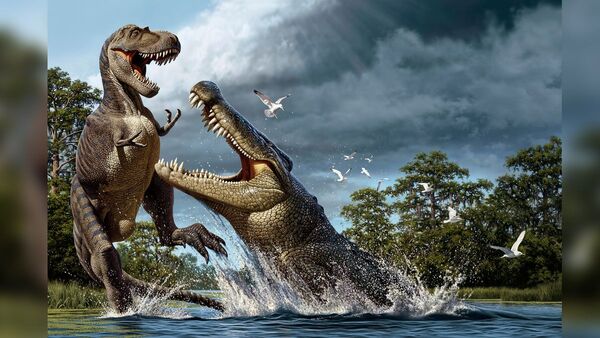Crocodiles and dinosaurs are two of the most fascinating groups of reptiles in the animal kingdom. While often seen as distinct entities, their relationship is deeply intertwined through the branches of the evolutionary tree. This article delves into the evolutionary history, anatomical similarities, and ecological roles of both groups, providing a comprehensive understanding of their relationship.

Crocodiles and dinosaurs share a common ancestor that lived approximately 250 million years ago during the Triassic period. This ancestor was part of a group called Archosauria, which means "ruling reptiles." From this lineage, two major branches emerged: the Ornithodira (which includes pterosaurs and birds) and the Pseudosuchia (which includes crocodilians).
As the Mesozoic Era progressed, dinosaurs and crocodiles began to diverge significantly. Dinosaurs dominated terrestrial ecosystems, evolving into various forms, from the towering sauropods to the fearsome theropods. In contrast, crocodiles remained more aquatic and semi-aquatic, adapting to life in rivers, lakes, and coastal environments.
Crocodiles and dinosaurs exhibit several anatomical similarities that highlight their shared ancestry. Both groups possess a similar skull structure, characterized by an elongated snout, sharp teeth, and a robust jaw. Additionally, they share a specific arrangement of bones in the skull and limbs, which reflect their common evolutionary origin.
Both crocodiles and many dinosaurs had tough, scaly skin, which provided protection from environmental factors and predators. While modern birds are the closest living relatives of dinosaurs, the scaly texture of crocodile skin serves as a reminder of the reptilian heritage they share.
Crocodiles are apex predators in their ecosystems, a role that can also be observed in many dinosaur species. The theropod dinosaurs, such as Tyrannosaurus rex, occupied similar ecological niches, preying on herbivorous dinosaurs. Both groups developed adaptations for hunting, including sharp teeth and powerful jaws.
While dinosaurs were primarily terrestrial, crocodiles adapted to a semi-aquatic lifestyle, allowing them to exploit different ecological niches. This adaptability has enabled crocodiles to survive various mass extinction events that wiped out many dinosaur species, showcasing their resilience.
The mass extinction event at the end of the Cretaceous period, around 66 million years ago, led to the extinction of most dinosaur species. However, crocodiles survived this catastrophic event, largely due to their adaptability and ability to thrive in various environments. Today, crocodilians are considered "living fossils," preserving many characteristics of their ancient ancestors.
The relationship between crocodiles and dinosaurs is a fascinating testament to the complexities of evolution. Sharing a common ancestor, these two groups have followed divergent evolutionary paths while retaining certain anatomical and ecological similarities. Understanding their relationship not only sheds light on the history of reptiles but also highlights the resilience of life on Earth. As we continue to study these remarkable creatures, we gain deeper insights into our planet's biological heritage.
By exploring the evolutionary links between crocodiles and dinosaurs, we appreciate the intricate web of life that has shaped the world we inhabit today.
When we think of ancient reptiles, dinosaurs often steal the spotlight with their massive sizes and diverse forms. However, a surprising contender emerges: crocodiles! Let’s delve into the comparison.
Crocodiles are often referred to as "living fossils," having survived multiple mass extinction events, including the one that wiped out the dinosaurs 66 million years ago. Their adaptability to various environments has ensured their survival, while dinosaurs vanished.
Crocodiles are apex predators in aquatic ecosystems, maintaining balance in their habitats. In contrast, dinosaurs occupied diverse terrestrial niches, from herbivores to apex predators. While dinosaurs were remarkable, crocodiles excel in their specific environments.
Here's a detailed comparative analysis of crocodiles and dinosaurs, presented in a table format:
| Feature | Crocodiles | Dinosaurs |
|---|---|---|
| Ancestry | Descended from archosaurs | Also descended from archosaurs |
| Time Period | Evolved in the Late Triassic | Dominant from the Late Triassic to the end of the Cretaceous |
| Habitat | Semi-aquatic, freshwater, and coastal | Primarily terrestrial |
| Body Structure | Robust body, elongated snout | Varied body shapes; bipedal and quadrupedal forms |
| Skin | Tough, scaly, with bony plates (osteoderms) | Varied; some had feathers, many had scales |
| Diet | Carnivorous; primarily piscivorous | Varied; herbivorous, carnivorous, and omnivorous |
| Reproductive System | Oviparous (lay eggs) | Oviparous (lay eggs) |
| Thermoregulation | Ectothermic (cold-blooded) | Varied; many may have been warm-blooded |
| Social Behavior | Solitary or in small groups | Varied; some species exhibited social behavior in herds |
| Survival | Survived mass extinction events | Most went extinct during the Cretaceous–Paleogene extinction event |
| Modern Relatives | Living descendants of ancient crocodilians | Birds are considered modern descendants of theropod dinosaurs |
This comparison highlights the distinct differences and similarities between crocodiles and dinosaurs, providing a clear understanding of their evolutionary paths and adaptations.
Both share common ancestry, but crocodiles boast unique adaptations like powerful jaws and specialized skin. Dinosaurs, with their varied forms and structures, showcased evolutionary innovation, but crocodiles’ efficiency and robustness give them an edge in survival.
While dinosaurs captivate our imagination, crocodiles emerge as the surprising winner in terms of resilience and adaptability. They continue to thrive today, proving that sometimes, survival trumps size!
animal tags: Crocodiles Dinosaurs
We created this article in conjunction with AI technology, then made sure it was fact-checked and edited by a Animals Top editor.